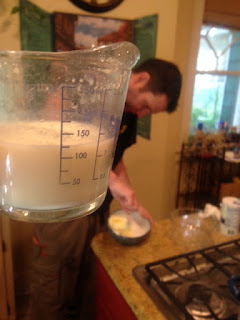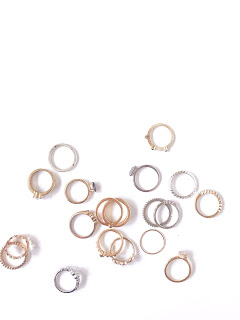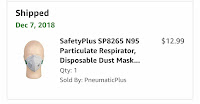All about butter
What is better than fresh-baked bread?
You might think the correct answer is "nothing" but it's "fresh-baked bread dripping with homemade butter."
Even if you are lucky enough to be eating homemade bread, you are probably not topping it with fresh butter. But butter is fun and easy to make, and certainly worth the effort at least once in a while. If you have children around, they'll love making it!
Today I taught my friend John how to make butter -- one of the components of the "Bread, Butter and Cheese" cooking class.
The baguettes were shaped and proofing in the oven and the milk was being allowed to set into curds for mozzarella so it was a good time to whip up some butter. And whip is literally how we made it. I don't have one of those antique churns (I'd love one, but they've grown extremely pricey in recent years) so I make butter in a somewhat less romantic but more practical way, with a hand mixer.
Literally, all you have to do to the whipping cream is agitate it. You could simply shake the carton. But I suggest you pour it into a deep mixing bowl and use a hand mixer.
It works better if you allow the cream to sit out for a bit rather than whip it at fridge temperature, but don't worry about it if you don't have the patience to wait an hour. Simply start whipping the cream, and in fairly short order you'll hit the whipped cream stage. You could stop here if you wanted, actually, and either serve the whipped cream or add a light touch of sugar and vanilla and have chantilly cream. But that's another subject. I will say, however, that it's helpful to pay close attention to the stages the cream goes through on its way from cream to whipped cream to butter -- one of the things you don't want to do when making whipped cream is to overwhip it. So it can be difficult to know if you've whipped as much air into it as possible without going past the whipped cream stage and right into butter. So every so often, turn off the mixer, and lift it out of the mixture so you can assess the peaks formed. One more note: if you're actually going for whipped cream you want your cream and whipping utensils to be well chilled, and if you're going for butter you want the cream to sit out a bit before whipping it, so although the cream will whip on its way to butter, it's best to have a definite aim in mind before you start -- butter or whipped cream, either one -- and to choose the temperature of the cream accordingly. There are complicated science reasons why, having to do with how the fat behaves at various temperatures. But never mind that. Just trust me on this.
OK. So we've been whipping the cream for a bit and it is starting to look like pretty good whipped cream. Keep going. Pretty soon it looks like very good whipped cream. You might be tempted to give it a taste. Hey, why not? Go ahead, I'll wait.
Good, huh? But keep going. Soon you will notice the cream is looking a bit more yellow, and is breaking down somewhat. Keep going. You'll begin to see a liquid beginning to form, then more liquid. You'll realize that hey, this suddenly does look like butter ... gobs of butter in a milky solution.
Use a spoon to press the butter into a big mass and pour off the buttermilk. Drink the buttermilk, because it is delicious. It is not the cultured dairy product called buttermilk you'll find in the dairy case. It's much sweeter and thinner.
You can wash the butter in a bowl of water and ice cubes at this stage -- really all you do is drop the butter into the very cold water and work it through your fingers a bit and then dump off the water -- but I've never managed to keep butter around long enough for this stage to be necessary. Don't skip it if you want the butter to keep more than a few days, though You will want to work in a small amount of salt for flavor. Sometimes it's nice to work in a touch of honey, too. Honey butter is a treat not to be missed, but plain old lightly salted butter is so good on its own that you don't really need anything else.
You might think the correct answer is "nothing" but it's "fresh-baked bread dripping with homemade butter."
Even if you are lucky enough to be eating homemade bread, you are probably not topping it with fresh butter. But butter is fun and easy to make, and certainly worth the effort at least once in a while. If you have children around, they'll love making it!
Today I taught my friend John how to make butter -- one of the components of the "Bread, Butter and Cheese" cooking class.
The baguettes were shaped and proofing in the oven and the milk was being allowed to set into curds for mozzarella so it was a good time to whip up some butter. And whip is literally how we made it. I don't have one of those antique churns (I'd love one, but they've grown extremely pricey in recent years) so I make butter in a somewhat less romantic but more practical way, with a hand mixer.
Literally, all you have to do to the whipping cream is agitate it. You could simply shake the carton. But I suggest you pour it into a deep mixing bowl and use a hand mixer.
It works better if you allow the cream to sit out for a bit rather than whip it at fridge temperature, but don't worry about it if you don't have the patience to wait an hour. Simply start whipping the cream, and in fairly short order you'll hit the whipped cream stage. You could stop here if you wanted, actually, and either serve the whipped cream or add a light touch of sugar and vanilla and have chantilly cream. But that's another subject. I will say, however, that it's helpful to pay close attention to the stages the cream goes through on its way from cream to whipped cream to butter -- one of the things you don't want to do when making whipped cream is to overwhip it. So it can be difficult to know if you've whipped as much air into it as possible without going past the whipped cream stage and right into butter. So every so often, turn off the mixer, and lift it out of the mixture so you can assess the peaks formed. One more note: if you're actually going for whipped cream you want your cream and whipping utensils to be well chilled, and if you're going for butter you want the cream to sit out a bit before whipping it, so although the cream will whip on its way to butter, it's best to have a definite aim in mind before you start -- butter or whipped cream, either one -- and to choose the temperature of the cream accordingly. There are complicated science reasons why, having to do with how the fat behaves at various temperatures. But never mind that. Just trust me on this.
OK. So we've been whipping the cream for a bit and it is starting to look like pretty good whipped cream. Keep going. Pretty soon it looks like very good whipped cream. You might be tempted to give it a taste. Hey, why not? Go ahead, I'll wait.
Good, huh? But keep going. Soon you will notice the cream is looking a bit more yellow, and is breaking down somewhat. Keep going. You'll begin to see a liquid beginning to form, then more liquid. You'll realize that hey, this suddenly does look like butter ... gobs of butter in a milky solution.
Use a spoon to press the butter into a big mass and pour off the buttermilk. Drink the buttermilk, because it is delicious. It is not the cultured dairy product called buttermilk you'll find in the dairy case. It's much sweeter and thinner.
 |
| In the foreground is the buttermilk left after turning a carton of milk into butter. In the background, John Reedy is mixing salt into the fresh butter. |



Comments
Post a Comment